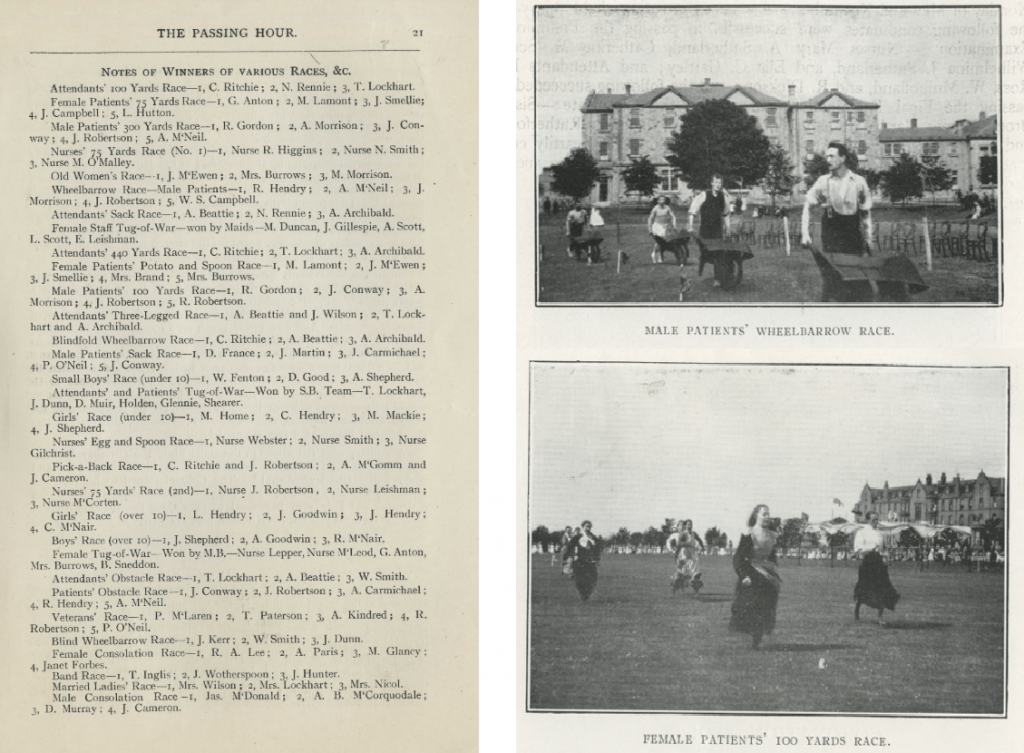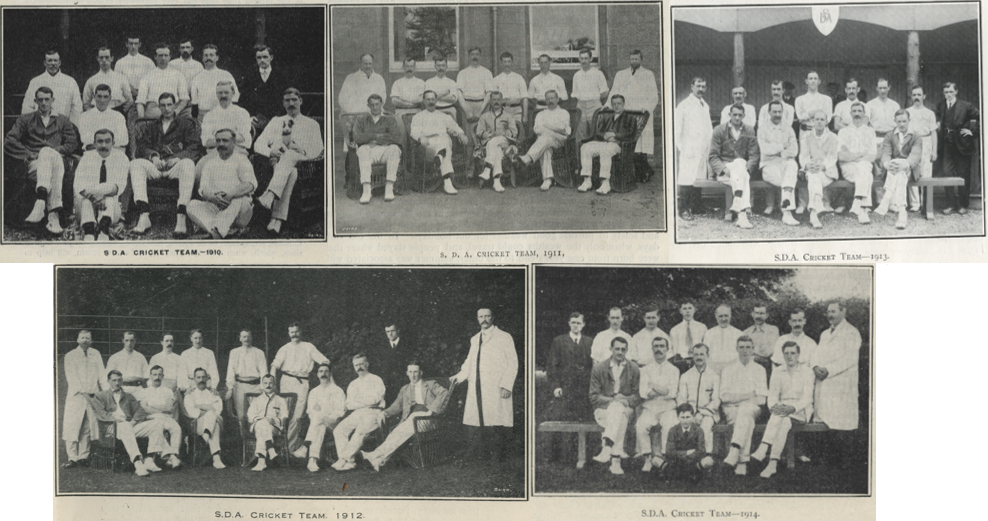The Passing Hour, the magazine of the Stirling District Asylum, which was published from 1901 up until the First World War, is a mine of information on life at the hospital. Side by side with the serialised stories written by staff and patients alike, are the reports of dances, theatre troupes and entertainers coming from all over the UK to put on a show for the patients, congratulations to staff as they pass their proficiency exams and, almost unfailingly, something about sport at the institution.
From The Passing Hour, we can tell that SDA had a full sporting calendar – from cricket and bowling clubs which played all summer to football and the odd billiards tournament during the winter time. There’s even a passing mention of winter hockey in 1906.
Football fixtures and results are dutifully noted every season but there is rarely an additional comment; a billiards report might briefly dwell on handicaps and the reports on bowling tend to venture no further than an account of the annual opening of the green. At SDA, it seems to be cricket that was the out and out passion of staff and patients alike – that is, if the four page reports of the season, the team photographs and the occasional ‘cricket issue’ are anything to go by!

We can gather from the many reports and from the names of players which cannot be found in our admission registers that the teams were most often comprised of staff members. That patients were primarily spectators seems to be made clear in a report made by a patient in the April-May-June 1911 issue on the games day held in celebration of the coronation of King George V and Queen Mary:
“Among the means for the amelioration of the mentally afflicted, rational, innocent amusement hold a prominent, if subordinate, place. The high pressure of modern life, its dangerous intricacies, the tendency to forget the calls of Nature in the pursuit of gold or even in one’s avocation, oft-times results in the breakdown both of bodily and mental health. To sit for a long time in a room is at least monotonous, and for the young to be compelled to sit long with only those of mature years becomes irksome. Sports, such as we enjoyed, take us for the time out of ourselves, and our very applause of successful performances affords a natural outlet for animal spirits.”
However, it would be incorrect to say that patients never took part at all. It seems from this report on batting averages from the September-October 1906 issue that patients made it onto the SDA Cricket Club team and for a most successful season.

Aside from team sports that played year in, year out, there were the occasional sports days where we know that both staff and patients took part in their droves. As mentioned above, one such day was in celebration of the 1911 coronation and another day which is recounted in The Passing Hour is put on in 1913 simply due to donations from ‘grateful friends of recovered patients’ making it financially possible. At both, the festivities centre around races divided into every category you could think of: Male Staff, Male Patients, Female Staff, Female Patients, Married vs Single Male Staff, Old Women Patients, Young Boys (under 10), you name it!
The variety of races is also prodigious, though our favourite has to be the Blind Wheelbarrow race from 1913 where the competitor is blindfolded and has a guide sitting in their wheelbarrow to direct their course of travel.

The fixtures lists always make for an interesting read, with SDA playing teams from other asylums (there is one fleeting mention of an inter-asylum championship) such as Royal Edinburgh, Dundee, Perth District, Woodilee and Gartloch, with whom SDA seemed to have a friendly rivalry and firmly established annual home and away games for both the cricket and the football, referred to as ‘the events of the football season’. Beyond this, it is also clear that SDA played a wide range of teams that were not comprised of asylum staff, many local names appear on the fixtures lists for both football and cricket with the SDA football team even playing the Edinburgh Civil Service and the Edinburgh University First XI in a particularly strong season in 1913 (the first and only year that the football team photo appears in The Passing Hour). Some team names suggest at being hospital teams – Stirling Victoria who play SDA at cricket was surely a team from Stirling’s Victoria Convalescent Home? Some are a little harder to place – is Haddington a local team or a team attached to Haddington District Lunatic Asylum? Or perhaps a bit of both as we do know the sometime captain of SDA’s cricket team Dr Anderson also played for Stirling County Cricket Club and even represented Scotland in International Matches against the West Indies in 1906. Undoubtedly, SDA played a broad range of opponents in both sports and all were welcome. A 1909 issue mentions a cricket match with the West of Scotland where Australian players were attempting to come over from Ireland to play.
Sadly the First World War not only eventually halts the printing of The Passing Hour in 1917 but it puts a stop to sports at SDA. Many of the fit and able male staff leave to fight for King and country while nurses and doctors leave to administer to the troops and The Passing Hour is, instead, filled with news of these men and women with letters both from the front and from staff home on leave. In 1915, it is reported that Dr Chisholm has managed to rustle up enough folk for just two teams to play each other at cricket and bowling on Saturdays but this is all that’s left in The Passing Hour of SDA’s previous enthusiasm for sports.
Nevertheless, we do have accounts of staff still playing regular matches against other hospitals in the 1980s and an oral history project conducted by Scotspeak in 1998 with patients and staff at SDA – then named Bellsdyke – shows that patients still ran in races and football and cricket were still played regularly – there’s even a mention of badminton!


But where does the fellow at wicket come in I should like to know, particularly with those fast erratic bowlers who send a ball in as if it were a shot from a gatling-gun. Take me for example. I want to play cricket, and my girl wants me to play. She says it’s such a nice, manly, athletic game. But, I give you my word, after these few weeks’ play, I am blue spots all over. As if I had been painted like one of my own early ancestors, and had only succeeded in washing it off in patches.
Vol. XIII, No. 2, April-May-June 1913